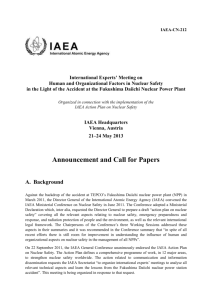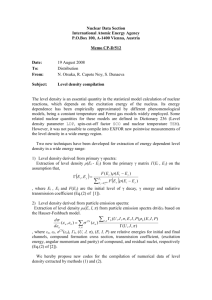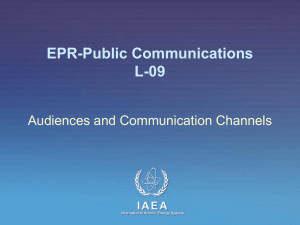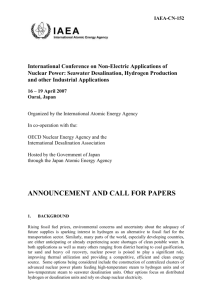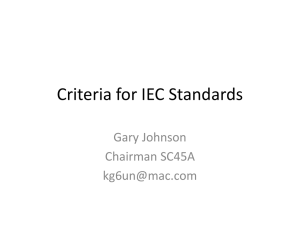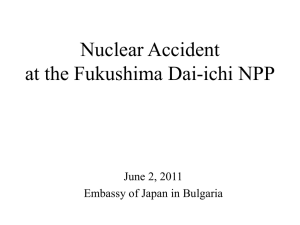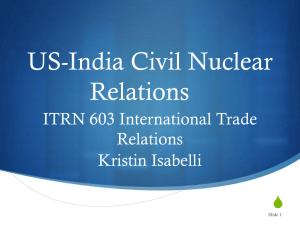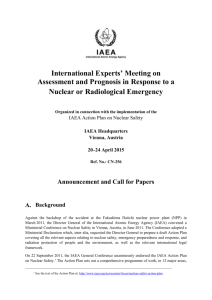Word - International Atomic Energy Agency
advertisement
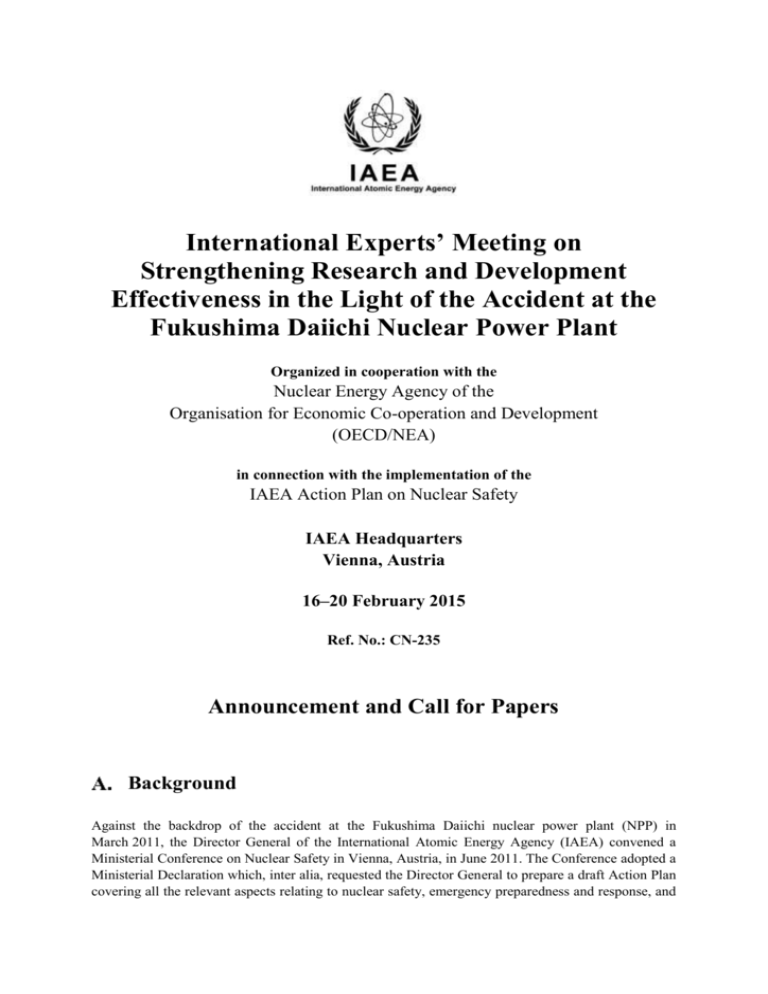
International Experts’ Meeting on Strengthening Research and Development Effectiveness in the Light of the Accident at the Fukushima Daiichi Nuclear Power Plant Organized in cooperation with the Nuclear Energy Agency of the Organisation for Economic Co-operation and Development (OECD/NEA) in connection with the implementation of the IAEA Action Plan on Nuclear Safety IAEA Headquarters Vienna, Austria 16–20 February 2015 Ref. No.: CN-235 Announcement and Call for Papers Background Against the backdrop of the accident at the Fukushima Daiichi nuclear power plant (NPP) in March 2011, the Director General of the International Atomic Energy Agency (IAEA) convened a Ministerial Conference on Nuclear Safety in Vienna, Austria, in June 2011. The Conference adopted a Ministerial Declaration which, inter alia, requested the Director General to prepare a draft Action Plan covering all the relevant aspects relating to nuclear safety, emergency preparedness and response, and Page 1 radiation protection of people and the environment, as well as the relevant international legal framework. On 22 September 2011, the IAEA General Conference unanimously endorsed the approval of the draft IAEA Action Plan on Nuclear Safety by the Board of Governors.1 The Action Plan sets out a comprehensive programme of work, in 12 major areas, to strengthen nuclear safety worldwide. Under one of these areas, headed “Research and development”, the IAEA Secretariat is requested to effectively utilize research and development (R&D) and to provide relevant stakeholders with assistance as appropriate to conduct necessary R&D in nuclear safety, technology and engineering, including that related to existing and new design-specific aspects. Another area under the Action Plan is headed “Communication and information dissemination” and focuses on enhancing the transparency and effectiveness of communication as well as improving the dissemination of information. In this connection, the Action Plan calls upon the IAEA Secretariat to organize international experts’ meetings (IEMs) to analyse all relevant technical aspects and learn the lessons from the Fukushima Daiichi accident. This IEM, which is the eighth such meeting since the first IEM in March 2012, is being organized in support of these actions. When the Fukushima Daiichi accident occurred, there was an extensive R&D database for water cooled reactor (WCR) severe accidents, and the information already known was very useful for predicting and understanding the accident progression. Nevertheless, the Fukushima Daiichi accident has highlighted some areas where the knowledge and understanding of issues associated with severe accidents could be strengthened. In particular, it is timely to re-evaluate the effectiveness and preparedness of the technical measures for severe accident management and to improve and further develop technologies to cope with severe accidents more effectively and efficiently. In the light of the Fukushima Daiichi accident, new R&D activities have been undertaken by IAEA Member States, as well as by the Nuclear Energy Agency of the Organisation for Economic Co-operation and Development (OECD/NEA) and other international organizations, dealing with severe accidents at NPPs, including those affecting spent fuel pools. This IEM is being organized to facilitate the exchange of information on these R&D activities and to further strengthen international collaboration among Member States and international organizations. Objectives The objective of this IEM is to provide a forum for experts from Member States and international organizations to exchange information and experience related to R&D work undertaken in the light of the Fukushima Daiichi accident, with a view to assisting Member States in planning and implementing R&D activities in nuclear safety, technology and engineering for existing NPPs and in the design of new plants. The IEM will be of interest to experts representing NPP operating organizations, research institutes, nuclear reactor vendors, nuclear regulatory bodies and technical support organizations (TSOs). ___________________________________________________________________________ 1 See the text of the Action Plan at: http://www.iaea.org/newscenter/focus/actionplan/reports/actionplanns130911.pdf. Page 2 The IEM will focus on: Collecting information from Member States and international organizations on reactor technologies that are designed to cope with severe accidents, including those technologies already proven or under development; Sharing among Member States and international organizations the most recent information on R&D activities dealing with severe accidents; Discussing and assessing the features and effectiveness of the technologies to prevent or mitigate severe accidents, as well as the challenges presented by these technologies; Identifying and prioritizing the R&D areas in which possible international collaboration would be beneficial and/or necessary; and Summarizing the current status of R&D activities on severe accidents after the Fukushima Daiichi accident. Topics The participants in the IEM will share information on the ongoing efforts and the results obtained in R&D work on reactor technologies to prevent or mitigate severe accidents at nuclear reactors and spent fuel pools based on technical lessons learned from the Fukushima Daiichi accident. Specifically, the IEM will address work and achievements in R&D related to the following topics: Topic 1: Common cause failures due to external and internal events o Measures to protect NPPs against extreme external events • Protection against earthquakes and tsunamis • Protection against severe weather, tornadoes and other natural hazards o Protection of off-site and on-site power supplies against external and internal events o Measures to enhance resistance to internal events • Protection against fires, internal flooding and other internal events Topic 2: Technologies to prevent/mitigate severe accidents o Measures to prevent/mitigate core damage o Measures to maintain containment/confinement integrity o Measures to prevent hydrogen explosions o Instrumentation for safety-related parameters and monitoring equipment under severe accident conditions o Measures to suppress radioactive material release/transport Page 3 Topic 3: Severe accident analysis o Analysis of accident progression and critical issues o Development/improvement of analysis tools for severe accidents o Effective utilization of probabilistic safety analysis methodologies for risk assessment and management o Deterministic and probabilistic analysis of spent fuel pools o Research related to source term calculation and radioactive material release/transport Topic 4: Emergency preparedness and response o On-site emergency response facilities, equipment and procedures o Off-site infrastructure resilience o Accident management for multi-unit sites and across multiple sites o Research related to atmospheric dispersion and consequences of contamination Topic 5: Post-accident recovery o On-site post-accident stabilization activities o On-site waste management o Off-site remediation and waste management o Fuel and fuel debris removal (characterization, dose reduction, remote technologies) o Decommissioning after an accident Format The IEM will be held at the IAEA’s Headquarters in Vienna, Austria, from 16 to 20 February 2015. An opening address will be delivered by a senior IAEA representative. The meeting will consist of an opening plenary session, topic-specific technical sessions, some of which are to be run in parallel, panel discussions, poster presentations and a closing plenary session. The opening plenary session will include keynote presentations by invited internationally recognized experts. Presentations will be given by experts from the IAEA Member States, the IAEA and other international organizations, and will focus on national and international R & D programmes developed in the aftermath of the Fukushima Daiichi nuclear accident. The plenary session will provide an opportunity to consider what R&D activities are being undertaken and what has been achieved since the accident, and to summarize the R&D work that remains to be done in the area of severe accidents. The technical sessions will feature oral presentations and discussions by and among internationally recognized experts and participants which will focus on the specific R&D work to cope with severe accidents. Discussions will be held from the perspective of operating organizations, research institutes, nuclear vendors, regulatory bodies and TSOs. Summaries of the presentations and discussions, including lessons learned, and recommendations for further activities, as well as input for future R&D areas and their priorities, will be prepared by the Page 4 Chairperson(s) of the IEM and the Co-Chairpersons of each session and will be presented at the closing plenary session. An annotated programme will be made available on the IEM web page (see Section L below) in due course. Submission and Acceptance of Synopses Extended synopses on issues falling within the topics outlined in Section C may be submitted as contributions to the IEM. All contributed synopses must present original work and should not have been published elsewhere. There will be sessions at the IEM for those who have contributed a synopsis to give an oral and/or poster presentation of their work. A small number of poster presentations may also be selected for oral presentation. E.1. Submission of Synopses Experts from Member States who wish to give a presentation at the IEM must submit an extended synopsis (in English) of maximum 800 words (i.e. two A4 format pages of single spaced typing, or the equivalent, including any tables or diagrams and a few pertinent references) to be sent electronically to the general email address of the IEM Secretariat: IEM8@iaea.org. The synopses and the associated documents (see Sub-Section E.2. below) must be received by the IAEA by 31 October 21 November 2014. The synopsis should give enough information on the contents of the proposed paper to enable the Technical Programme Committee to evaluate it. Introductory and general matters should not be included. The synopsis — if accepted — will be reproduced in the Book of Extended Synopses. Authors are urged to make use of the Synopsis Template in Word format that will be made available on the IEM web page (see Section L below). E.2. Acceptance of Synopses An extended synopsis will be considered only if the Participation Form (Form A) and Form for Submission of a Paper (Form B) have been received by the indicated deadline and through the appropriate official channels. Authors will be informed by 1 December 15 December 2014 as to whether their synopses have been accepted by the Technical Programme Committee. Guidelines for the preparation of presentations and posters will be provided at that time. Advance copies of presentations/posters have to be submitted by 31 January 2015. Given the need to provide ample time for discussion, the number of presentations that can be accepted is limited. If the number of relevant and high quality synopses that are considered worthy of selection exceeds the acceptable number, some of them may be selected for poster presentation instead. The IEM Secretariat reserves the right to exclude synopses that do not comply with the IAEA’s quality standards and/or do not apply to one of the topics listed in Section C. The proceedings of the IEM will be made available online to Member States through the IAEA Action Plan on Nuclear Safety dashboard: http://www-ns.iaea.org/actionplan/default.asp Page 5 The proceedings will include the Chairpersons’ summaries, the presentations, the outcomes of panel discussions and recommendations. Participation The IEM is targeted primarily at experts in research institutes and nuclear vendors from IAEA Member States involved in the planning, management, implementation and evaluation of R&D activities related to severe accidents, as well as experts from operating organizations, regulatory bodies and TSOs. All experts designated by Member States to participate in the meeting are requested to register online in advance through the IEM web page (see Section L). In addition, they are required to send a completed Participation Form (Form A) and, if applicable, the Form for Submission of a Paper (Form B) and the Grant Application Form (Form C) to the competent national authority (e.g. the Ministry of Foreign Affairs or National Atomic Energy Authority) for subsequent transmission to the IAEA by email to: Official.Mail@iaea.org. Participants will be accepted only if the Participation Form is transmitted through the competent national authority of a Member State of the IAEA. Participants whose official designations have been received by the IAEA will receive further information on the IEM approximately two months before the beginning of the meeting. This information will also be posted on the IEM web page. Expenditures No registration fee is charged to participants. The IAEA is generally not in a position to bear the travel and other costs of participants in the IEM. The IAEA has, however, limited funds at its disposal to help meet the cost of attendance of certain participants. Such assistance may be offered upon specific request to normally one participant per country provided that, in the IAEA’s view, the participant on whose behalf assistance is requested will make an important contribution to the IEM. If governments wish to apply for a grant on behalf of one of their experts, they should address specific requests to the IAEA to this effect. Governments should ensure that applications for grants are submitted by 31 October 21 November 2014 and that they are accompanied by a duly completed and signed Grant Application Form (Form C). Approved grants will be issued in the form of a lump sum payment that usually covers only part of the cost of attendance. Page 6 Key Deadlines Submission of Extended Synopsis together with Forms A and B 31 October 21 November 2014 Submission of Grant Application Form (Form C), if applicable 31 October 21 November 2014 Submission of advance copy of presentation/poster 31 January 2015 Working Language The working language of the IEM will be English. All communications, synopses and documentations must be sent to the IAEA in English. Visas Designated participants who require a visa to enter Austria should submit the necessary application to the nearest diplomatic or consular representative of Austria at least four weeks before they travel to Austria. Since Austria is a Schengen State, persons requiring a visa will have to apply for a Schengen visa. In States where Austria has no diplomatic mission, visas can be obtained from the consular authority of a Schengen Partner State representing Austria in the country in question. IEM Secretariat General contact details of the IEM Secretariat: International Atomic Energy Agency (IAEA) Vienna International Centre PO Box 100 1400 VIENNA AUSTRIA Ref.: IAEA-CN-235 Tel.: +43 1 2600 Fax: +43 1 26007 Email: Official.Mail@iaea.org Page 7 IAEA Scientific Secretaries: Mr Katsumi Yamada Nuclear Power Technology Section Division of Nuclear Power Department of Nuclear Energy Tel.: +43 1 2600 22882 Fax: + 43 1 26007 Email: IEM8@iaea.org Development Mr Anthony Ulses Safety Assessment Section Division of Nuclear Installation Safety Department of Nuclear Safety and Security Tel.: +43 1 2600 22686 Fax: + 43 1 26007 Email: IEM8@iaea.org Administration and organization: Ms Martina Neuhold Conference Services Section Division of Conference and Document Services Department of Management Ref.: IAEA-CN-235 Tel.: +43 1 2600 21314 Fax: +43 1 26007 Email: IEM8@iaea.org Subsequent correspondence on scientific matters should be sent to the Scientific Secretaries and correspondence on administrative matters to the IAEA’s Conference Services Section — in both cases by email to: IEM8@iaea.org. IEM Web Page Please visit the IEM web page regularly for new information regarding the meeting: http://www-pub.iaea.org/iaeameetings/48908/IEM8
